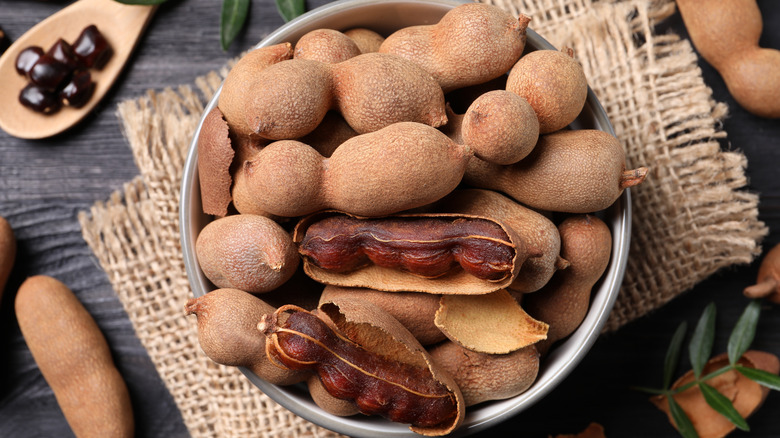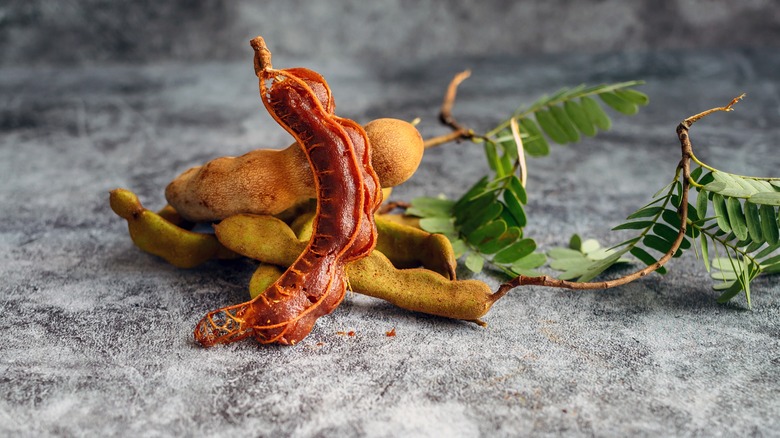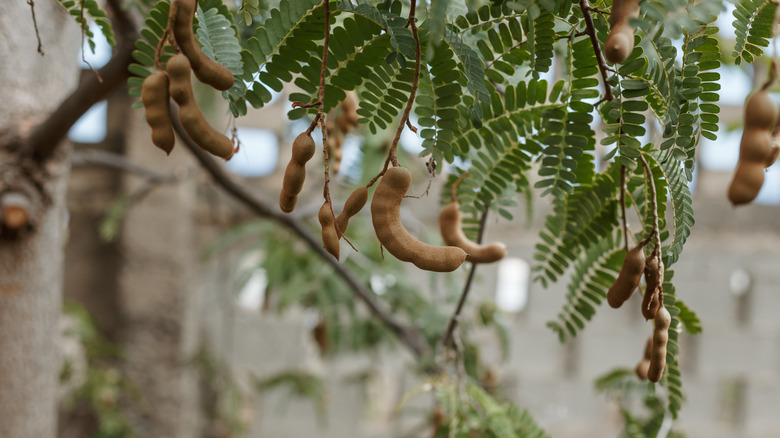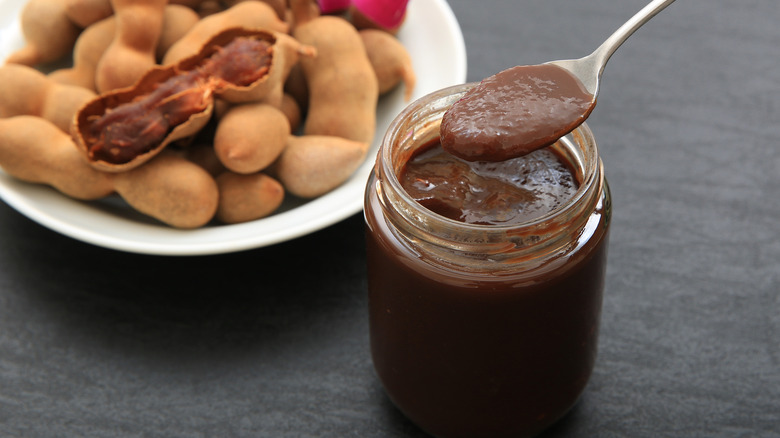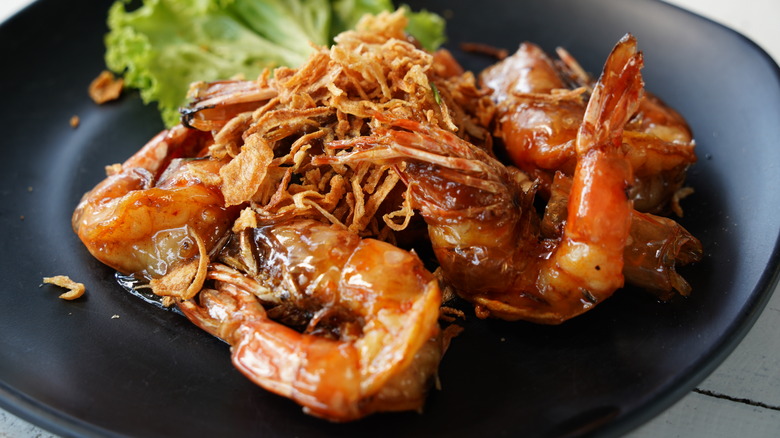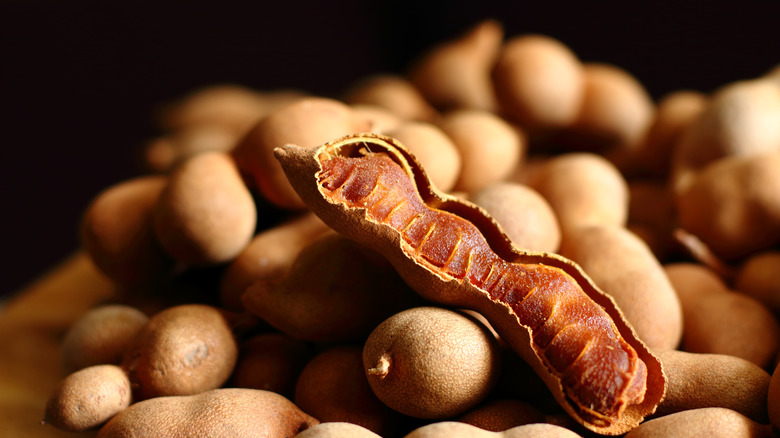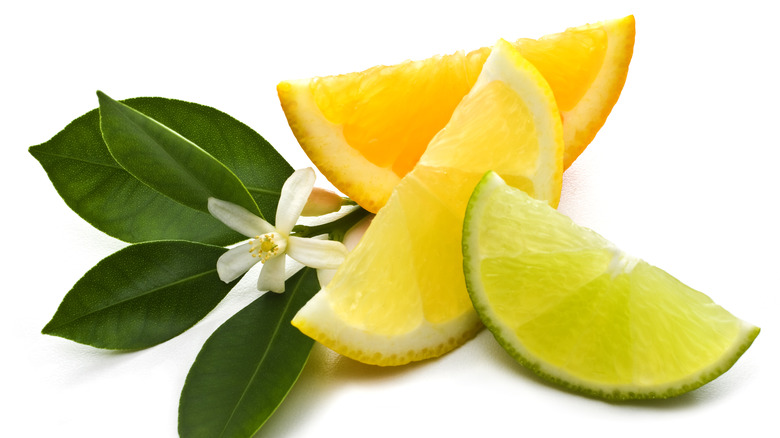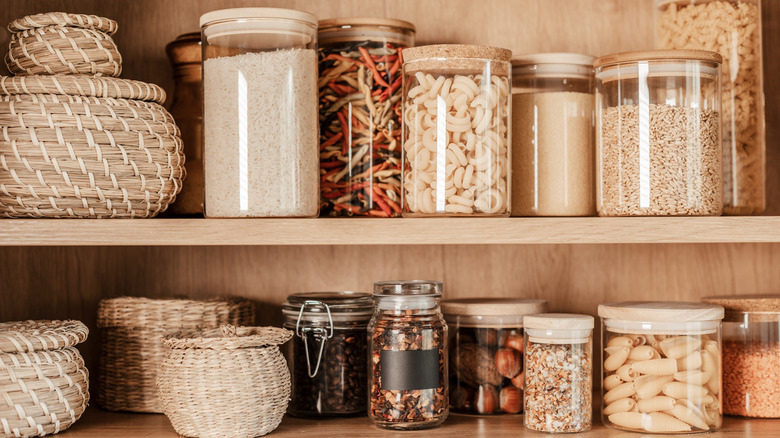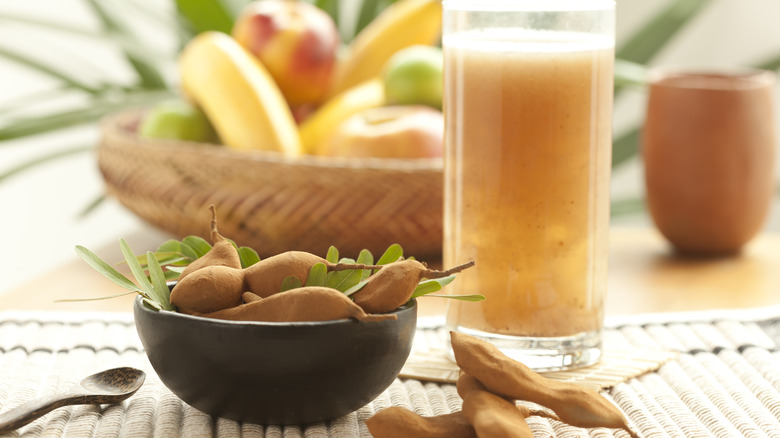What Is Tamarind And How Do You Cook With It?
We may receive a commission on purchases made from links.
Tamarind is tropical in nature and exotic in flavor, adding a unique layer to curries, chutneys, marinades, and even Worcestershire sauce (don't worry, we won't ask for pronunciation on that one). A culture-spanning culinary treat, this nifty little fruit is used across Indian, African, Thai, Mexican, and Middle Eastern cuisines. Some of the myriad dishes it pops up in are the traditional pad Thai, Massaman chicken curry, grilled ribs, chutney, soup, and desserts. It's even added to global cocktails for a fruity vibe mixed with a spicy or sour touch.
We think you should be using it in your everyday cooking to spice up your lunch or add a distinct and bold touch to weeknight meals. If you've never used tamarind, or perhaps are saying "What the heck even is tamarind?" then you'll want to keep reading. We've scoured the internet, perused local grocery stores, and used some of our own taste-testing experience to bring the tamarind lowdown to your kitchen counter.
What is tamarind?
Tamarind is classified as a legume and grows in pods which, when mature, are brown and plump, ranging from 3 to 9 inches in length. It resembles a peanut (also a legume, by the way), but unlike the peanut, tamarind pods are filled with seeds and a sticky sweet-sour pulp. The pulp is usually turned into a paste, juice, or concentrate.
The word tamarind means "Indian date" and is an accurate description, as it features a date-like consistency in its raw form. It contains tartaric acid, which acts as a tenderizer and makes it an excellent choice for meat and fish. This is likely the reason it's used in Worcestershire Sauce.
When creating tamarind paste, the shells and seeds are removed and the pulp is pressed into a block. Thick and molasses-like in texture, tamarind paste can be used right out of the container. Tamarind concentrate is a form where the pulp has been boiled down before preservatives are often added. It is also available as a powder, like a traditional spice, which is made from dehydrated and ground tamarind. This form has a much more intense sweet and sour flavor than fresh tamarind.
Where does tamarind come from?
Tamarind fruit grows on a tree (the Tamarindus indicus) that's native to Africa and Asia but is cultivated in India, Central America, and other tropical climates like Thailand and Jamaica. There are two main varieties of tamarind trees: a sweet-flavored one that's grown in Thailand and a sour one that's grown around the rest of the world. India produces 300,000 tons of the fruit annually with Thailand generating 140,000 tons making these two countries the world's top tamarind producers.
If you're interested in growing a tamarind tree, just know that it can grow up to 80 feet tall and become 7 meters in circumference. They can live for up to 200 years and prefer acidic soil and dry, humid regions. Trees can be sown from the seeds in the pods but it can take eight to 10 years for the tree to produce fruit. So, patience is the key!
What does tamarind taste like?
Tamarind features the complex and sweet flavors of molasses and caramel with the more acidic flavors of citrus, apricots, and dates. In fact, the texture of the paste is reminiscent of dates. Pulparindo, a Mexican tamarind pulp and similar to a fruit roll-up but flat, highlights this flavor experience by starting with a sweet taste and ending on a spicy and bitter note.
The seeds of tamarind are also edible and can be picked, cracked open, and eaten right off the tree in their rawest and least processed form. They can also be eaten roasted, or dried. They're described as having a nutty flavor with notes of caramel and chocolate. However, when unripe, tamarind has a quite bitter, sour taste.
Tamarind's Caribbean roots are right at home in Jamaican Choice's tamarind balls. These Jamaican-style balls are a sweet and simple treat, consisting of tamarind pulp rolled into balls and then dusted with sugar. They offer more of a sweet flavor than Pulparindo, which shows off the spicier side of the tamarind flavor.
How do you cook with tamarind?
Tamarind's unique flavor profile makes it an exceptionally versatile ingredient. Combined with coconut aminos, honey, and garlic, tamarind paste makes a wonderful glaze for fish or chicken. Mix with ginger snap cookies and brownies or blend it into a paste that can be poured over most sweet desserts.. Use a dash of tamarind concentrate to add flavor to soups, stews, and gravies. Using tamarind paste gives a nice spicy addition to the creaminess of chickpea and tahini hummus.
For drinks, use tamarind syrup to add flavor and depth to cocktails such as daiquiris, whiskey sours, Arnold Palmers, and tequila-based beverages. Use tamarind paste to make a refreshing tamarind tea. Mexican agua fresca de tamarindo, or "tamarind water," is another popular tamarind-flavored beverage and can be found in the popular Jarritos brand of flavored water/soda.
When cooking with tamarind pods, they need to be cracked open first. Bend the pod with your hands, peel away the shell, and remove the strings from the seeds. Next, place the flesh and seeds in boiling water and let sit for a couple of hours. At this point, it will be soft enough that you can push the mixture through a strainer to separate the pulp from the seeds. If under-ripe, you can still use tamarind but it just needs to be cooked or pickled and then cut out from the seeds and used in Indian pickles.
Where can you buy tamarind?
Tamarind is available in the form of raw pods, pressed blocks, and as a paste (also called a concentrate) as well as syrup, candy, and powder form. You can purchase tamarind at Asian, Latin, and Caribbean markets as well as local grocery stores, Walmart, and online retailers like Amazon, Tropical Fruit Box, and Pure Indian Foods.
When shopping for fresh tamarind pods, look for a deep brown color, which indicates a ripe pod. You'll want to choose pods that feel plump and have a smooth and shiny surface. Cracks in the surface can indicate damage or a pod that's overly dried out. Pods should have a sweet and tangy fragrance.
Tamarind concentrate, or paste, is about the easiest way to buy pre-packaged tamarind. Tamicon, TAJ Gourmet Foods, Sambar Kitchen, and Pure Indian Foods are all wonderful ways to enjoy pastes, chutneys, and other tamarind products if you don't want to make them yourself.
What can you use as a substitute for tamarind?
If you don't have tamarind (and, let's face it, it's not something many of us have just hanging out in the spice rack), you can use equal parts brown sugar and lime or lemon juice as a substitute. Another choice is equal parts pomegranate molasses and Worcestershire Sauce or lime juice. The acidity in tamarind is close to that in traditional citrus fruits, which is what makes limes such a great substitute. For that sweet touch, you can add a dash of honey or maple syrup along with the lime juice. Since Worcestershire sauce has tamarind in it, it can make a terrific substitute on its own in a pinch.
Balsamic vinegar also makes a wonderful and convenient substitute for tamarind. It's not one you might immediately think of, but it features the same sweet and sour notes as tamarind. Mix equal parts rice vinegar or white wine with equal amounts of brown sugar. You'll get acidity from the wine or vinegar and sweetness from the brown sugar. Another substitute for tamarind is amchur powder. This rather unknown ingredient is made from unripe mangoes. You'll want to mix equal parts powder and water to create a tamarind-like paste.
How should you store tamarind?
Since it's a fruit of sorts, fresh tamarind has a short shelf life. You can store tamarind pods in a plastic bag in a cool location, for two months. It can be kept in the fridge for up to three months if stored in a sealed container and up to a year if placed in the freezer. To preserve tamarind even longer, up to two years, use the salting method. Peel the pulp away from the seeds. Roll into small pieces. Fill each piece with salt as you roll it into a ball. Place in a stoneware container and cover with even more salt.
Tamarind paste or concentrate purchased in a jar can be stored on the shelf in the pantry, but it should be refrigerated after opening. If unopened and stored properly, tamarind paste has an expiration date of about a year. Just remember to store tamarind powder in a cool and dark location.
If stored improperly, tamarind can lose that tangy flavor and deep color. Excess moisture can cause it to spoil, which results in mold and odor. In fact, moisture is one of the top reasons tamarind will spoil and clump. As long as it's kept cool, dry, and airtight, you should be good to go.
Nutritional content of tamarind
Tamarind is high in nutrients such as magnesium, potassium, iron, and vitamins B1, B2, and B3. Per 120 grams, tamarind 6 grams of fiber, 3 grams of protein, less than 1 gram of fat, and 287 calories. The calories are almost all from sugar, as is common with most fruits. Magnesium plays an important role in more than 600 body functions such as helping to lower blood pressure and offering anti-inflammatory and anti-diabetic properties.
Tamarind also contains polyphenols, a naturally occurring plant compound that acts as an antioxidant and can help keep cholesterol levels in check as well as protect against heart disease and prevent peptic ulcers. Tamarind also has natural compounds that might have antifungal, antibacterial, and antiviral properties. It has even been used to treat malaria. It's worth noting that tamarind is used as a laxative, and diuretic, so you might want to consider that before ingesting too much!
Methodology
This information has been brought to you by fine folks around the internet via various reputable outlets and verifiable recipe blogs. The author also used their own experience and their own ready and willing taste-testing volunteers.
